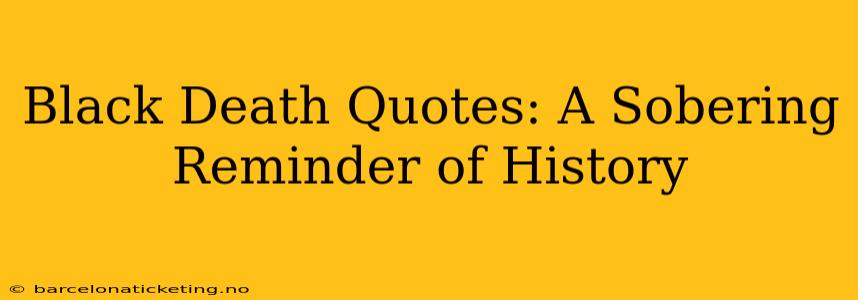The Black Death, a bubonic plague pandemic that ravaged Europe and beyond in the mid-14th century, left an indelible mark on history. More than just a historical event, it was a profound societal upheaval that reshaped economies, religions, and social structures. While precise numbers remain debated, estimates suggest it wiped out 30-60% of Europe's population. To understand the magnitude of this catastrophe, exploring firsthand accounts and reflections offers a chilling perspective. This article delves into some of the most powerful quotes from the era, providing context and analyzing their lasting impact.
What were the major causes of the Black Death?
The Black Death was primarily caused by the bacterium Yersinia pestis, spread through the bites of infected fleas living on rodents, particularly black rats. The densely populated cities of the time, coupled with poor sanitation and hygiene, created ideal breeding grounds for the disease. The rapid spread across continents was facilitated by trade routes, particularly seafaring vessels that carried infected rodents and fleas along their journeys. It's crucial to remember that understanding of disease transmission was extremely limited during this period, leading to widespread fear, misinformation, and ineffective countermeasures.
What were the symptoms of the Black Death?
Symptoms varied depending on the type of plague. Bubonic plague, the most common form, presented with swollen, painful lymph nodes (buboes), fever, chills, and weakness. Septicemic plague, a more rapidly fatal form, caused internal bleeding, organ failure, and sepsis. Pneumonic plague, spread through respiratory droplets, affected the lungs, causing coughing, shortness of breath, and bloody sputum. The speed and severity of the illness instilled terror in the population, leading to widespread panic and social breakdown.
How did the Black Death affect society?
The Black Death's societal impact was profound and multifaceted. The massive loss of life led to labor shortages, triggering significant economic changes. The feudal system, already under strain, was further destabilized as the balance of power between lords and peasants shifted. Religious beliefs were challenged, with some questioning the Church's authority in the face of such widespread suffering. Art and literature reflected the anxieties and uncertainties of the time, often portraying death, decay, and the fragility of life. The pandemic also spurred advancements in medical understanding, although these were slow and incremental due to the limitations of the scientific knowledge at the time.
What are some famous quotes about the Black Death?
While there aren't many documented firsthand accounts that survive as easily quotable phrases, the historical record is filled with descriptions and narratives that evoke the terror and despair of the time. Chronicles, letters, and religious writings from the period often paint vivid pictures of death and suffering. For example, accounts describe overflowing cemeteries, the stench of death permeating the air, and families torn apart. These narratives, while not directly quotable in a concise way like some modern-day quotes, are profoundly moving and offer a powerful glimpse into the reality of the Black Death.
Did the Black Death impact religious beliefs?
The widespread death and suffering caused by the Black Death profoundly impacted religious beliefs throughout Europe. Some questioned the Church's authority, while others intensified their religious devotion, seeking solace and divine intervention. The flagellant movements, characterized by public self-flagellation, emerged as a response to the plague, reflecting the desperation and penitence of the faithful. This period of uncertainty led to religious questioning and, ultimately, laid the groundwork for religious reform movements in later centuries.
How did people try to prevent or cure the Black Death?
In the absence of scientific understanding, people relied on various methods to try and prevent or cure the Black Death, many rooted in superstition and folklore. These included burning herbs and incense to purify the air, wearing amulets or charms for protection, bloodletting, and administering various herbal remedies. While many of these practices were ineffective, or even harmful, they reflect the desperation of individuals in the face of an incurable and highly contagious disease. It wasn't until centuries later that the actual cause of the plague was understood, and effective treatments could be developed.
Conclusion
The Black Death remains a chilling reminder of humanity's vulnerability to disease and the devastating impact pandemics can have on society. While direct quotes from the era are scarce, the historical record is filled with powerfully evocative accounts that capture the fear, suffering, and societal upheaval of this dark chapter in human history. By studying these accounts, we gain a deeper understanding of the past and the lessons it holds for the future. Understanding the Black Death's impact helps us to better prepare for and respond to future health crises.

